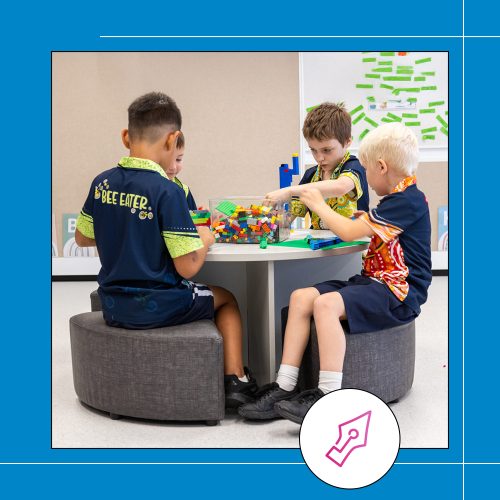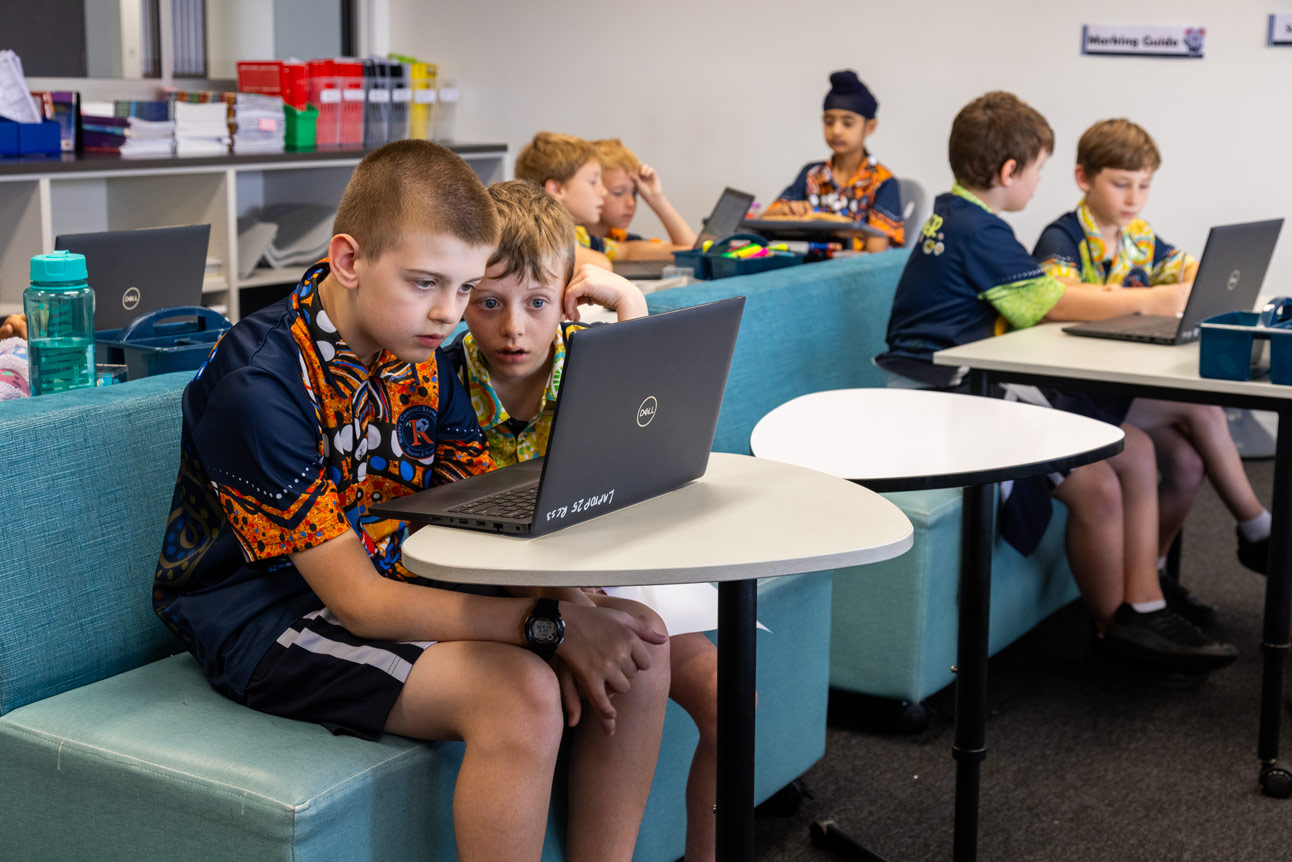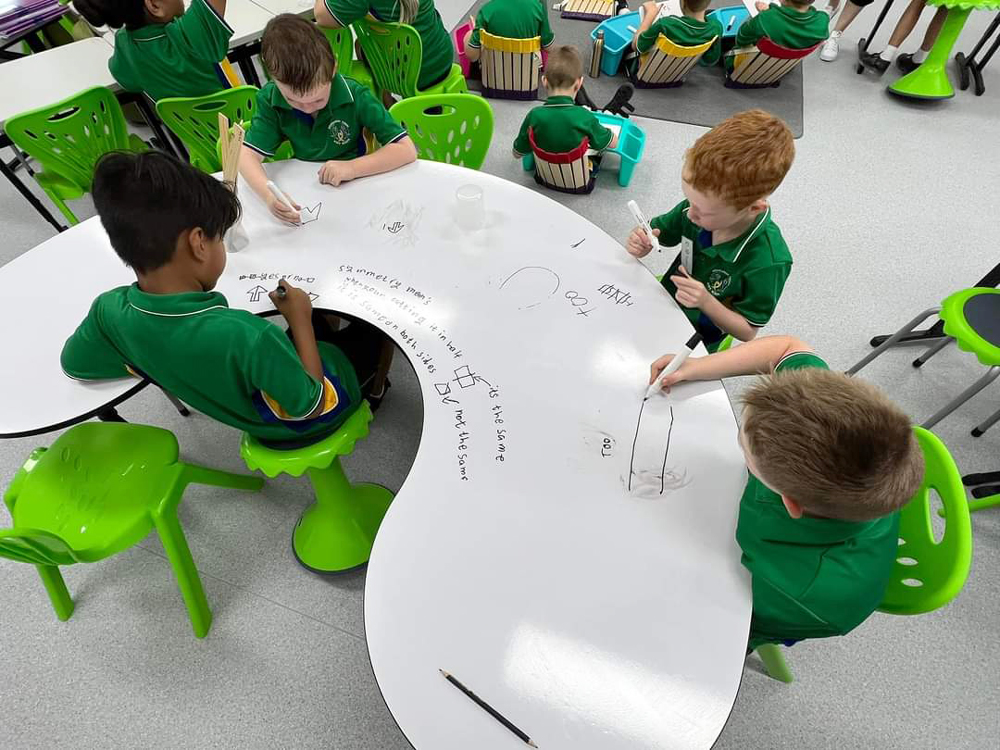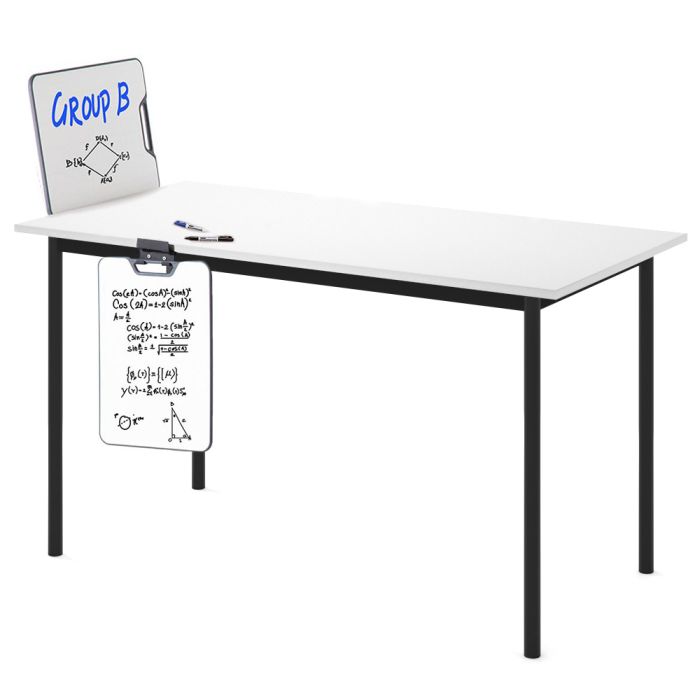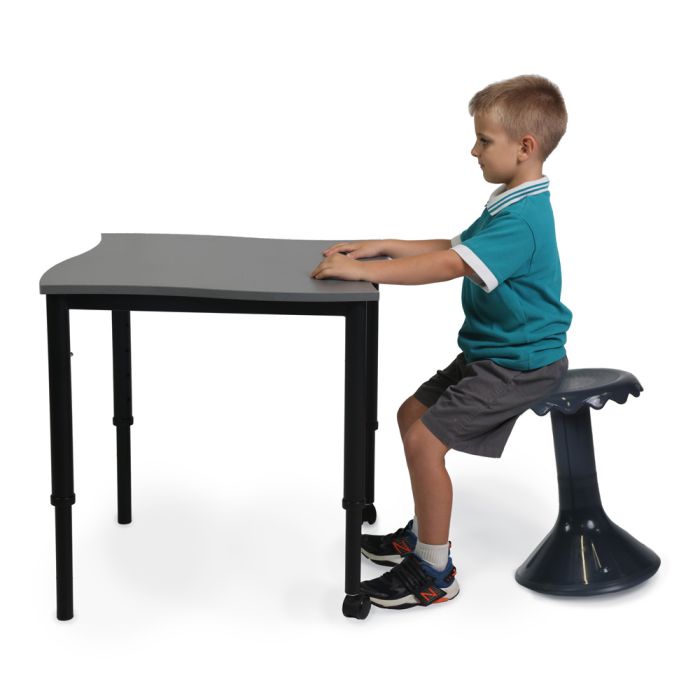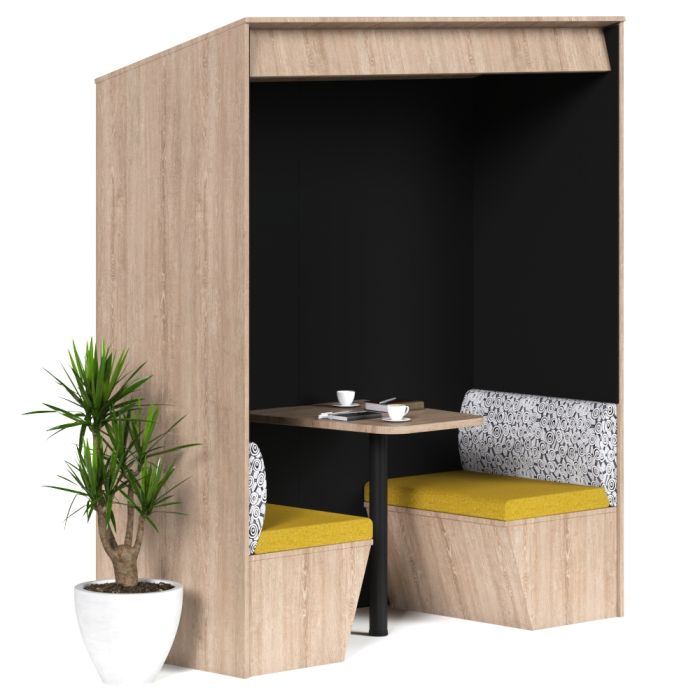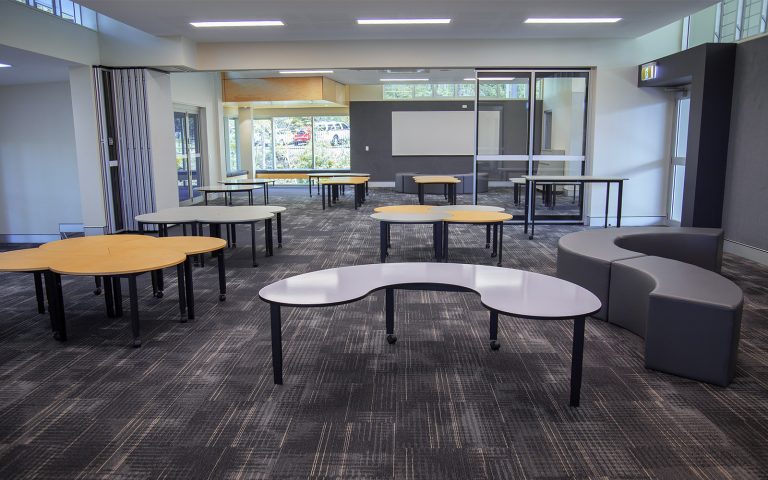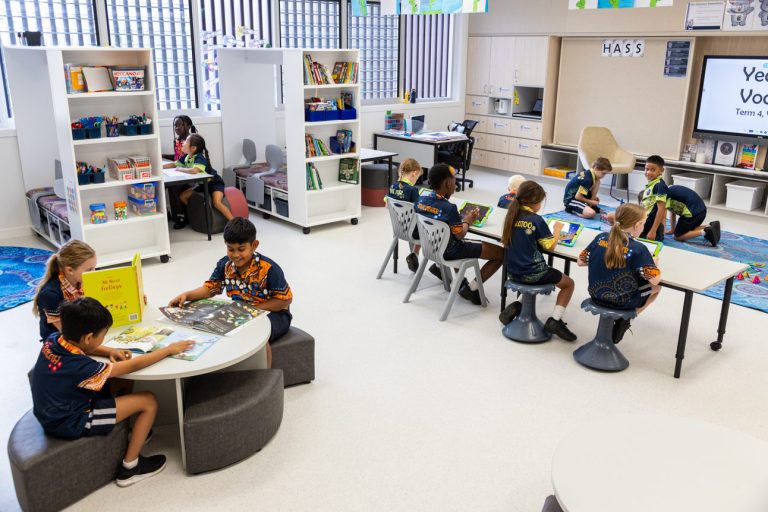A well-designed classroom does more than give students somewhere to work – it encourages students to think in different ways, nurturing skills they’ll need as they move through life.
From the moment a child walks into a learning space, their environment influences how they feel, think, and engage.
By intentionally designing a layout and selecting furniture that encourages creative and analytical skills, schools can improve academic outcomes and shape the thinkers our world needs in the future.
Why critical & creative thinking matters in the classroom
Creative and critical thinking are the foundations of deeper learning. They enable students to further their understanding and proficiency once a skill or concept has been taught.
Students who are taught to be curious, ask questions, evaluate ideas, and think outside the box become better problem solvers. They gain confidence to explore different solutions, adapt to new challenges, and collaborate meaningfully with peers.
Research shows that students in environments that encourage creativity tend to have higher academic performance and motivation (OECD, 2019). Encouraging divergent thinking—where multiple ideas are considered—also supports the development of innovation skills from a young age.
Skills children need beyond school
When students leave school, the ability to think critically and creatively doesn’t just give them an advantage in tertiary education or the workplace, it becomes a life skill that helps them navigate financial, social, logistical and physical challenges.
Employers are increasingly looking for school leavers who can:
- Work independently and in teams
- Adapt to rapidly changing situations
- Show resilience in the face of challenges
- Communicate effectively and solve problems in the moment
A 2023 report by the Foundation for Young Australians found that critical thinking is one of the top three transferable skills sought by Australian employers, alongside creativity and collaboration.
Creative and critical thinking come from practice. This starts in a well-designed learning environment where teachers have the resources and furniture needed to support practice and experimentation.
The role of the physical environment in student thinking
The classroom and the furniture within aren’t just a backdrop to learning — they’re key players in cognitive development.
Louka Parry, CEO and Founder of The Learning Future, says: “The learning environment makes a huge impact on how learners learn, and teachers teach. Furniture is a critical component of any learning experience because it frames what we call the ‘third teacher‘ – the learning environment.”
Here’s what you need to consider when designing a learning space that enhances creative and critical thinking.
Design drives engagement
Studies have shown that the physical layout, furniture choice, and aesthetics of a classroom can significantly impact student engagement and academic performance (Barrett et al., 2015). Well-designed spaces can lead to a 16% improvement in learning outcomes.
Design choices influence:
- Focus and attention spans
- Sense of belonging and safety
- Willingness to collaborate or take intellectual risks
Learning environments can spark creativity
Spaces with both individual and group working zones, writeable surfaces, and comfortable yet flexible furniture encourage ideas to flow freely. When students can move, stand, sit, sketch, or shift group dynamics mid-task, they can experience thinking as a physical and social process — not just a mental one.
Everyone is inspired in different ways – some need colour, some like views of the natural environment, and others like an uncluttered neutral space. Equally, some students like working at a desk while others prefer to curl up on a beanbag, so variety in the furniture, layout and decor is important.
Flexible Spaces, Flexible Minds
Modular school furniture, like configurable seating and whiteboard tables, helps educators adapt the space to meet different teaching modalities. Whether students are collaborating on a group project or thinking quietly on their own, the furniture can shift with them.
The benefits of modular learning furniture include:
- Quick reconfiguration for group or solo work
- Encouragement of ownership and agency
- Easy transitions between activities
Consider these examples of layouts that invite creative and analytical discussion:
- Clustered desks with shared whiteboard tables for group brainstorming*
- Open zones with soft seating for peer-to-peer conversation
It’s equally important to have quiet corners with single desks for independent critical analysis
Schools across Australia are adopting these models. See how they’ve transformed classrooms in our learning space design gallery. You can also read more about how writeable surfaces benefit engagement here.
Comfort and Wellbeing: The Unsung Heroes of Thinking
Use ergonomics to encourage focus
Students can’t think clearly if they’re uncomfortable. Ergonomic furniture that supports proper posture can help reduce fatigue and physical distraction. Chairs that promote movement (like happy stools) and height-adjustable desks enable longer periods of sustained thinking.
Use lighting, colour, & acoustics to shape mood
- Natural light has been shown to improve alertness and memory retention
- Warm, muted colours can reduce anxiety and create a calm atmosphere for reflection and analysis
- Brighter colours can inspire movement, energy, and outside-the-box thinking
- Sound-absorbing materials support focus by reducing background noise. (BFX’s Audio Art products also add visual interest to a space).
These subtle design decisions have a powerful impact on creativity and critical thought. BFX’s approach to learning space design considers all sensory inputs to create balanced, student-centric environments.
Purposeful zones for every learning mode
Great classrooms don’t just have one mode — they have many. By zoning areas for different types of learning, students can match their thinking to the space.
Examples include:
- Reflection pods for journaling or critical analysis
- Collaboration hubs for creative group tasks (the Café Duo Booth is ideal for senior secondary students)
- Exploration zones with movable furniture (most BFX desks can have castors attached) and writeable walls for ideation
Real Examples for Inspiration
Immanuel Lutheran College
BFX recently worked on a project with The Learning Future and Immanuel Lutheran College – a Prep to Year 12 school who have embraced the importance of learning environment design in equipping students with the creative and critical thinking skills they’ll need later in life. The college aims to ensure they set their students up for success in the future, equipping students with the skills, attitudes and habits to be incredible, caring humans who make a meaningful impact in the world. This meant rethinking their learning spaces:
“Partnering with BFX Furniture has been instrumental for the design and re-design of learning spaces here at Immanuel Lutheran College. We’ve been able to work with a company who puts learning before product – the product is there to ensure that learning has the best outcomes for students. For us, being able to have the BFX team come and work alongside us and The Learning Future to ensure contemporary pedagogies and student learning is engaging, powerful and connected to the future is so important.”
Eloise Beveridge, Principal, Immanuel Lutheran College.
Ripley Central State School
As part of a larger project, BFX worked with the school to create their much-prized Curiosity Centre (Resource Centre). The centre is designed in three zones – the central zone, the junior zone and the senior zone. A multi-purpose, innovative space, the furniture plays a role in encouraging curiosity – a critical driver of creativity and critical thinking. Agile, compatible furnishings in low heights were chosen to create a welcoming, uncluttered environment with the ability to create different layouts and fresh looks whilst maintaining a clear line of sight to all areas.
Final Thoughts
When we design classrooms that support creativity and critical thought, we prepare students for both assessments and life.
From modular school furniture to acoustically muted zones for thinking, each element of a learning space can serve a purpose: to empower students to think, question, explore, and grow.
Looking to transform your school environment?
Browse our future-focused learning spaces or connect with our expert team for a custom learning space design consultation.
Sources:
- Barrett, P., Zhang, Y., Moffat, J., & Kobbacy, K. (2015). The impact of classroom design on pupils’ learning. Building and Environment.
- OECD (2019). OECD Learning Compass 2030: A Series of Concept Notes.
- Foundation for Young Australians (2023). The New Work Reality Report.


